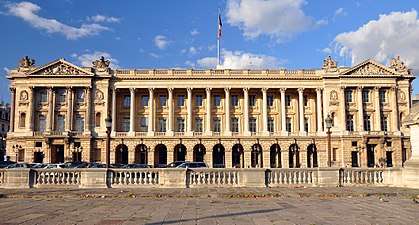Ministry of the Navy (France)
The Ministry of the Navy (French: Ministère de la Marine) was a section of the French government - apart from the Ministry of War - that was in charge of the French navy and colonies.
| Ministère de la Marine | |
 Hôtel de la Marine, which housed the Ministry | |
| Ministry overview | |
|---|---|
| Formed | 7 March 1669 |
| Dissolved | 22 October 1947 |
| Superseding agency |
|
| Jurisdiction | French colonial empire |
| Headquarters | Hôtel de la Marine 48°52′0.4″N 2°19′23.1″E |
| Minister responsible |
|
The ministry combined the administration of the navy, the colonies like New France and seaborne trade helping for example the French East India Company. A widely held view at the time was that for states to be powerful, wealthy and prestigious, colonies in the New World need to be maintained for their consequent trade. The maintenance of colonies through naval operations not only served to improve the stature of the state, but was also helpful in destroying their European rivals in North America.[1]
After the Second World War, the Ministry of the Navy was merged with the War Ministry, absorbing the role of the Minister of the Navy and Colonies, with a Minister of National Defence directing the entire military French forces.
Creation and History
Since the 16th century, the Secretary of State of the Navy (French: Secrétaire d'État de la Marine) was responsible for the French early navy and colonies.
In 1624, Louis XIII’s first minister, Cardinal Richelieu created the first model of the modern French Navy, also known as the Marine or La Royale, run by the Secretary of State of the Navy.[2] The official French Marine was not established until 7 March 1669 by Jean-Baptiste Colbert. At this time, the ministry of marine became an official government department with a permanent staff, holding offices at Versailles. All of the policies and procedures for the marine were established by Colbert.[1]
The Secretary of State of the Navy was responsible for the administration of both the navy (the "marine royale") and civilian (merchant marine) fleets, and for all France's ports, arsenals, consulates, and colonies, as well as the guardianship for all her commercial companies.
The two French royal fleets (the Ponant fleet and Levant fleet) were put under the control of Colbert from 1662, whilst he was "intendant des finances" and "minister of state"—but not "secretary of state" : he only became secretary of state in 1669 after having bought his way into the post. From then on, right up to the French Revolution, a secretary of state had responsibility for the fleet.
To his two original offices (the bureau du Ponant and bureau du Levant) other services were added over time:
- archives department, 1669 ;
- office of the Ponant consulates, 1709 ;
- office of the colonies, 1710 ;
- bureau des classes, 1711 ;
- department of maps and plans, 1720 ;
- Office of the Levant Consulates, 1738, which was in 1743 merged with the Office of the Ponant Consulates under the name of Office of Commerce and Consulates
These different offices and departments were regrouped into four super-departments by marshal de Castries in 1786.
In 1791, the Secretary of State of the Navy was changed to Minister of the Navy. Before the 1890s, this position also usually had responsibility for France's colonies, and was usually known as Minister of the Navy and Colonies (French: Ministère de la Marine et des Colonies). In 1947 the naval ministry was absorbed into the Ministry of Defence.
Personnel
At the head of the marine was the Ministre de la Marine, manned by a French statesman. Ministers of Marine typically came from families of administrative nobility (La Plume), such as the Phelypeaux’s. From 1690 until 1749, a Phelypeaux was secretary and minister in charge of the marine and its colonies. The most prominent of the family was Jean-Frederic Phelypeaux, comte de Pontchartrain et Maurepas. Under his guidance, the marine regained much of the strength and prestige that it had lost during the period of the Regencies (1715–1726). As well, he was able to ascertain much larger than normal budgets for the Marine. Thus under Jean-Frederic’s leadership, France was able to regain its reputation as a maritime power.[3]
List of ministers
References
- Miquelon, Dale. "Ministère de la Marine". The Canadian Encyclopedia. Retrieved 27 August 2019.
- Miquelon, Dale (16 December 2013). "Compagnie des Cent-Associés". The Canadian Encyclopedia. Retrieved 27 August 2019.
- Rule, John C., "Jean-Frederic Phelypeaux, comte de Pontchartrain et Maurepas: Reflections on His Life and His Papers", The Journal of the Louisiana Historical Association Vol 6: 1965, p 365-377
Bibliography
- Jean-Philippe Zanco, Dictionnaire des Ministres de la Marine 1689-1958, S.P.M. Kronos, Paris 2011.